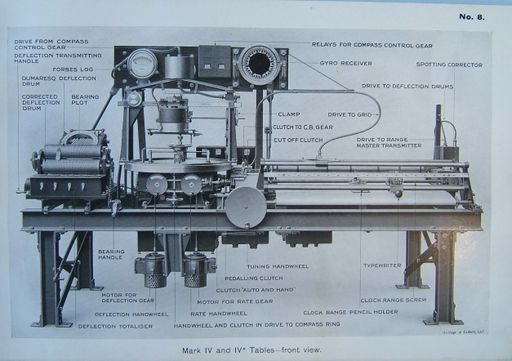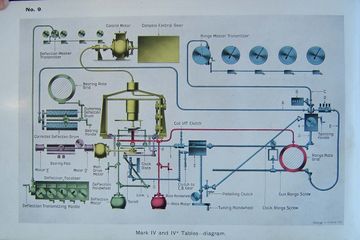Difference between revisions of "Dreyer Table Mark IV*"
m |
|||
| Line 1: | Line 1: | ||
| − | [[File:DreyerTableMarkIVAndIVStar_front_1918.jpg|thumb|512px|'''Mark IV* Dreyer Table c1918, front'''<br>Shown with a [[Standard Bearing Plot]] which was probably never actually used. Notice the elaborate [[Electrical Dumaresq]] which could automatically transfer rates, and the [[Range Typewriter]] which replaced the [[ | + | [[File:DreyerTableMarkIVAndIVStar_front_1918.jpg|thumb|512px|'''Mark IV* Dreyer Table c1918, front'''<br>Shown with a [[Standard Bearing Plot]] which was probably never actually used. Notice the elaborate [[Electrical Dumaresq]] which could automatically transfer rates, and the [[Range Typewriter]] which replaced the [[Brownrigg Keyboard]]s the tables used until 1917.{{CN}} ]] |
The '''Mark IV* Dreyer Table''' was developed in 1915 to embody small improvements in the [[Mark IV Dreyer Table]]s developed just a year prior. The changes modest enough that some of the Mark IV tables were later updated to the Mark IV* standard without the need for outright replacement. | The '''Mark IV* Dreyer Table''' was developed in 1915 to embody small improvements in the [[Mark IV Dreyer Table]]s developed just a year prior. The changes modest enough that some of the Mark IV tables were later updated to the Mark IV* standard without the need for outright replacement. | ||
| Line 41: | Line 41: | ||
===Spotting Corrector=== | ===Spotting Corrector=== | ||
| + | By 1919, nine of the 19 ships equipped with Mark IV and later tables had a worm-drive into their spotting corrector which moved the zero under the influence of a transmitter at the [[Dreyer Calculator]]. In this manner, the correction would shift the zero of the spotting corrector, and its operator could follow-up to apply it to the gun range.<ref>''Reports of the Grand Fleet Dreyer Table Committee, 1918-1919'', p. 8.</ref> | ||
===Range Plot=== | ===Range Plot=== | ||
| Line 92: | Line 93: | ||
==Bibliography== | ==Bibliography== | ||
| − | + | {{refbegin}} | |
*{{BibUKDreyerTableHandbook1918}} | *{{BibUKDreyerTableHandbook1918}} | ||
*{{BibBrooksDreadnoughtGunnery}} | *{{BibBrooksDreadnoughtGunnery}} | ||
| Line 98: | Line 99: | ||
*{{BibUKTechnicalHistoryComparisonArgoAndDreyer}} | *{{BibUKTechnicalHistoryComparisonArgoAndDreyer}} | ||
*{{BibUKDreyerTableMarkIVRoyalOak1916}} | *{{BibUKDreyerTableMarkIVRoyalOak1916}} | ||
| − | + | *{{BibUKReportsDreyerTableCommittee1919}} | |
| + | {{refend}} | ||
[[Category:Dreyer Fire Control Table]] | [[Category:Dreyer Fire Control Table]] | ||
[[Category:Fire Control]] | [[Category:Fire Control]] | ||
[[Category:Shipboard Equipment]] | [[Category:Shipboard Equipment]] | ||
Revision as of 15:38, 14 June 2011

Shown with a Standard Bearing Plot which was probably never actually used. Notice the elaborate Electrical Dumaresq which could automatically transfer rates, and the Range Typewriter which replaced the Brownrigg Keyboards the tables used until 1917.[Citation needed]
The Mark IV* Dreyer Table was developed in 1915 to embody small improvements in the Mark IV Dreyer Tables developed just a year prior. The changes modest enough that some of the Mark IV tables were later updated to the Mark IV* standard without the need for outright replacement.
The prototype of the new table was installed in Iron Duke in mid-August, 1914[1]

This illustrates the Standard Bearing Plot and its Deflection Totaliser which were featured so prominently in the 1918 Handbook, but which may never have been widely deployed if at all.

This illustrates the Standard Bearing Plot and its Deflection Totaliser which were featured so prominently in the 1918 Handbook, but which may never have been widely deployed if at all.
Contents
Development
The tables were 7.5 inches wider than the Mark IV tables to accommodate a range plot that was 7.5 inches wider.
| Overall Dimensions (1918)[2] | |
| Width | 9 feet, 10.5 inches |
| Depth | 4 feet, 6.5 inches |
| Height of Range Rate Grid | 3 feet, 5 inches |
| Height of top of dumaresq | 5 feet, 9 inches |
Motive Power
As in the Mark III design, the table had a electric motor that drove the paper plots and the range and bearing clocks and which could fall back to a hand-crank in case of power loss.
In addition, the table needed a pair of motors to pass range rate and deflection from the electrical dumaresq. This could not be powered from the handcrank alluded to above, but in cases of power failure, they'd be declutched and their follow-up function would be assigned to human use of a pair of small hand-wheels on the lower face of the dumaresq[Citation needed].
Electrical Dumaresq
An Electrical Dumaresq replaced the Mark VI dumaresq used in the Mark III table. It was helm-free like the Mark III's dumaresq by virtue of a gyro-compass input to allow it to track own heading. Its new virtue came from the even more cumbersome assembly that dangled from its dial plate which contained contacts to electrically prompt followers in the lower housing to track the range rate and deflection indicated on the dumaresq.
Range Clock
Bearing Clock
Spotting Corrector
By 1919, nine of the 19 ships equipped with Mark IV and later tables had a worm-drive into their spotting corrector which moved the zero under the influence of a transmitter at the Dreyer Calculator. In this manner, the correction would shift the zero of the spotting corrector, and its operator could follow-up to apply it to the gun range.[3]
Range Plot
The Mark IV's range plot was allowed plotting from 2,000 to 17,000 yards, and this was proving insufficient in light of early battle experience[Citation needed]. While the Mark IV tables received a retrofit in the form of an "extended range scale" that could boost their plot area to a new realm from 10,000 to 25,000 yards, this introduced complexity and created new ways the TS crew could make mistakes.
The expedient in the IV* table was to add 7.5 inches to the width of the range plot to give it a range envelope from 2,000 to 20,000 yards without need for an extended range scale or any other trickery.
Rate Grid The rate grid grew in sophistication by war's end, from one that had irregular markings to translate its wire angles to range rates to one with linear range rate markings, a flexible shaft to keep it aligned to the rate on the range clock, and a means of temporarily deflecting it to explore rates at variance with that set on the clock.
Plotting Range Cuts The Mark IV* tables used the rather clumsy but sufficient Brownrigg Keyboard through Jutland until a more elegant manual Range Typewriter was issued in 1917.[4] These tools gave them the ability to plot ranges from multiple rangefinders with an increased degree of ease and simplicity.
Range Pencils Initial production tables had a single red pencil to plot clock range. As early drawings imply it was first installed, it appears that the tuning handle had no pedalling clutch and so intrinsically altered clock range and gun range when it was used. This implies that the tuning handle would only be used at the beginning of an encounter.
[Citation needed][TO BE CONTINUED - TONE]
| Plotting Ranges | 2,000 - 20,000 yards (a +8,000 yard extended scale added later allowed plotting to 28,000 yards????)[5] |
| Paper width | 45 inches |
| Scale | 400 yards/inch |
| Paper speed | 2 inches / minute |
???? did these ever have these? The extended range scales were likely fitted to tables as opportunity around around the time (1915?) such a modification was made to ???? (Brooks)[Citation needed].
Bearing Plot
[TO BE CONTINUED - TONE] On plans drawn up in 1912-1913 and outlined in a Technical History drafted by Dreyer, the bearing plot was on paper 15 inches wide with a simple rate grid whose irregular edge markings as it was rotated converted the angle of rotation into a number of degrees per minute of bearing rate. By February, 1913, a single deflection drum could convert the bearing rate of the grid's inclination to a gun deflection.[6]
The Handbook for Capt F.C. Dreyer's Fire Control Tables, 1918 indicates that these were at some point to be provided with standard bearing plots[7], but these units received such scant service before the introduction of G.D.T. gear that it is hard to bank that many were actually fitted.
Deployment
See Also
Footnotes
- ↑ Brooks. Dreadnought Gunnery and the Battle of Jutland. p. 169.
- ↑ Dreyer Handbook, 1918 p. 90.
- ↑ Reports of the Grand Fleet Dreyer Table Committee, 1918-1919, p. 8.
- ↑ Brooks. Dreadnought Gunnery, p. 173.
- ↑ Dreyer Handbook, 1918 p. 17.
- ↑ , pPollen Aim Corrector System, Part I. Technical History and Technical Comparison with Commander F. C. Dreyer's Fire Control System, pp. 47-8.
- ↑ Handbook for Capt F.C. Dreyer's Fire Control Tables, 1918. pp. 13-15.
Bibliography
- Template:BibUKDreyerTableHandbook1918
- Template:BibBrooksDreadnoughtGunnery
- Template:BibBrooksThesis
- Template:BibUKTechnicalHistoryComparisonArgoAndDreyer
- Template:BibUKDreyerTableMarkIVRoyalOak1916
- Template:BibUKReportsDreyerTableCommittee1919